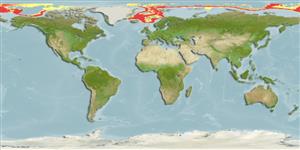Teleostei (teleosts) >
Perciformes/Zoarcoidei (Eelpouts and pricklebacks) >
Zoarcidae (Eelpouts) > Lycodinae
Etymology: Lycodes: Greek, lykos = wolf + Greek, suffix, oides = similar to (Ref. 45335).
Environment: milieu / climate zone / depth range / distribution range
Ecology
Marine; bathydemersal; depth range 475 - 3000 m (Ref. 58426), usually 1000 - 1800 m (Ref. 4695). Deep-water; 86°N - 63°N, 28°W - 75°W (Ref. 117245)
Northeast Atlantic: Norwegian Sea from Spitsbergen to the north side of the North Atlantic Ridge; Nunavut (Ref. 58426), northeast Greenland to Jan Mayen Island and north of Iceland. Arctic Ocean: northern Laptev Sea, East Siberian and Chukchi seas (Ref. 4695).
Size / Weight / Age
Maturity: Lm ? range ? - ? cm
Max length : 69.0 cm TL male/unsexed; (Ref. 11976); common length : 45.0 cm TL male/unsexed; (Ref. 4695)
Benthic (Ref. 58426). Feeds on fishes (Ref. 58426), bottom crustaceans (isopods, amphipods), ophiurids, cephalopods. Reproduces probably in early autumn. About 500 demersal eggs of 7 mm diameter (Ref. 4695).
Life cycle and mating behavior
Maturity | Reproduction | Spawning | Eggs | Fecundity | Larvae
Anderson, M.E. and V.V. Fedorov, 2004. Family Zoarcidae Swainson 1839. Eelpouts. Calif. Acad. Sci. Annotated Checklists of Fishes (34):58. (Ref. 51665)
IUCN Red List Status (Ref. 130435)
Threat to humans
Harmless
Human uses
More information
Common namesSynonymsMetabolismPredatorsEcotoxicologyReproductionMaturitySpawningSpawning aggregationFecundityEggsEgg development
ReferencesAquacultureAquaculture profileStrainsGeneticsElectrophoresesHeritabilityDiseasesProcessingNutrientsMass conversion
Tools
Special reports
Download XML
Internet sources
Estimates based on models
Preferred temperature (Ref.
123201): -0.9 - 3.6, mean -0.7 °C (based on 594 cells).
Phylogenetic diversity index (Ref.
82804): PD
50 = 0.5000 [Uniqueness, from 0.5 = low to 2.0 = high].
Bayesian length-weight: a=0.01000 (0.00244 - 0.04107), b=3.04 (2.81 - 3.27), in cm total length, based on all LWR estimates for this body shape (Ref.
93245).
Trophic level (Ref.
69278): 4.5 ±0.7 se; based on diet studies.
Generation time: 26.2 ( na - na) years. Estimated as median ln(3)/K based on 1
growth studies.
Resilience (Ref.
120179): Very Low, minimum population doubling time more than 14 years (Preliminary K or Fecundity.).
Fishing Vulnerability (Ref.
59153): High to very high vulnerability (71 of 100).
